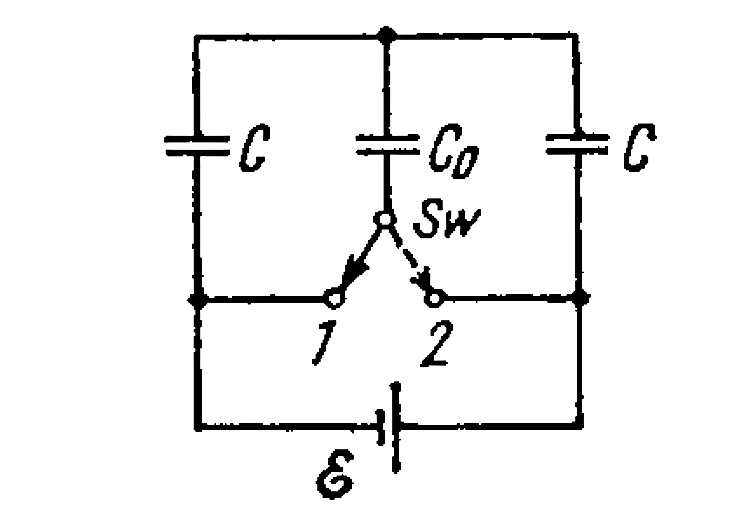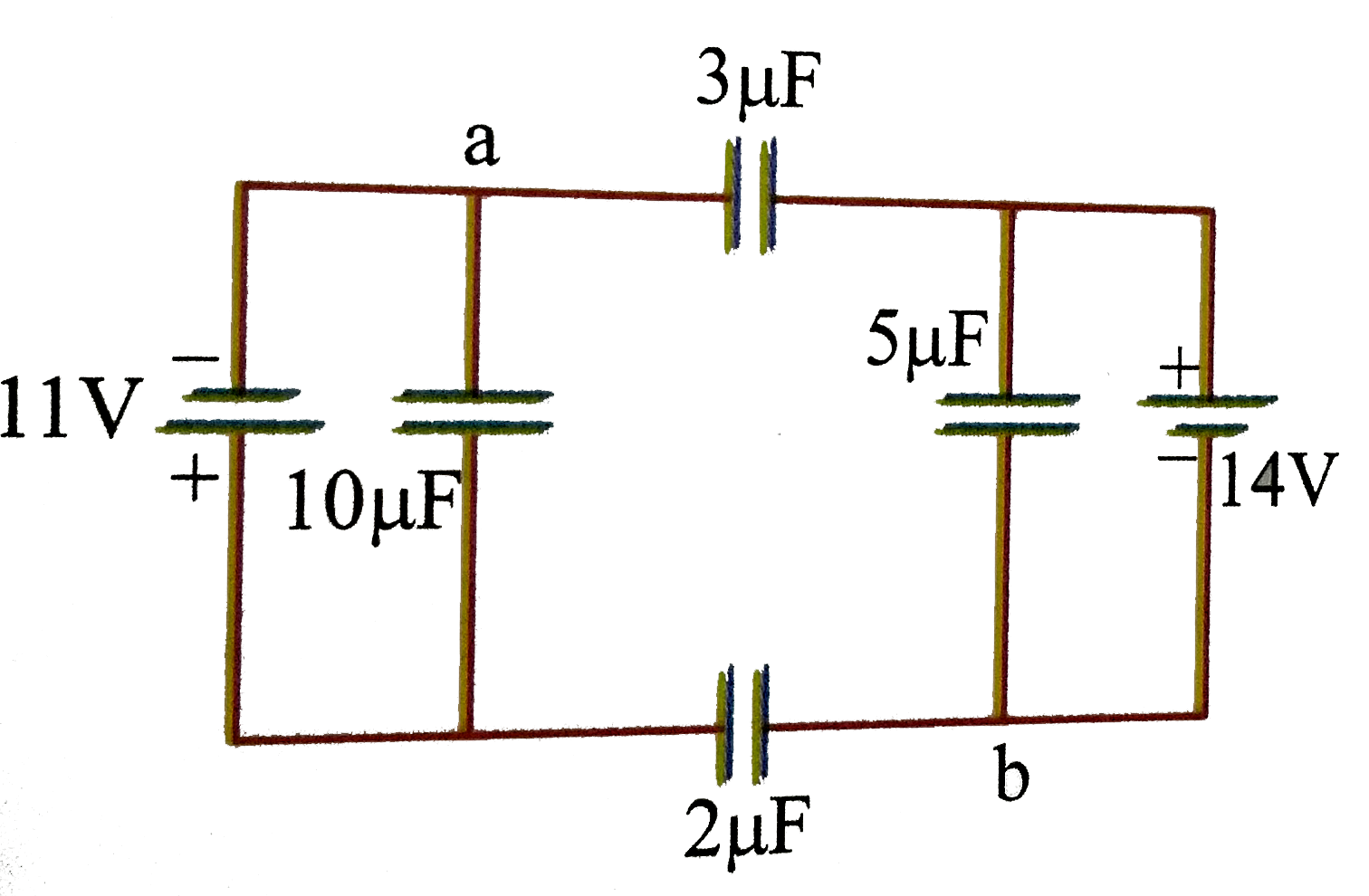Complete Solutions to Level-V of chapter CAPACITANCE of Class 12 book with complete answers and questions
| Class 12 | PHYSICS |
| Chapter | CAPACITANCE |
| NARAYANA | Level-V |
| Number Of Questions | 35 |
| Academic Year | 2023-24 |
`n` conducting plates are placed face to face. Distance between two consecutive plates is `d`.
Area of plates is `A,(A)/(2),(A)/(4),(A)/(8)....((1)/(2^(n-1)))A`
A dielectric slab of dielectric constant `k` is inserted between the first and second plates and the assembly is charged by a battery of `emf xi`. Find the charge stored in the assembly.
 .
.
View SolutionA capacitor of capacitance `10 m F` is charged up a potential difference of `2V` and then the cell is removed. Now it is connected to a cell of `emf 4V` and is charged fully. In both cases the polarities of the two cells are in the same directions. Total heat produced in the second charging process is :
View SolutionFor the circuit shown in figure, which of the following statements is true ?

View SolutionA parallel plate capacitor C with plates of unit area and separation d is filled with a liquid of dielectric constant `K=2`. The level of liquid is `d//3` initially. Suppose the liquid level decreases at a constant speed v, the time constant as a function of time t is-

View SolutionA dielectric slab of thickness `d` is inserted in a parallel plate capacitor whose negative plate is at `x=0` and positive plate is at `x = 3d`. The slab is equidistant from the plates. The capacitor is given some charge. As one goes from `0` to `3d(1998)`.
View SolutionWhat amount of heat will be generated in the circuit shown in Fig. after the swich `Sw` is shifted from position 2 ?

View SolutionA parallel plate capacitor was lowered into water in a horizontal position, with water filling up the gap between the plates. The distance between the plates is `d`. Then a constant voltage `V` was applied to the capacitor. Find the water pressure increment in the gap. Dielectric constant of water is `k`.
View SolutionThe gap between the plates of a parallel plate capacitor is filled with glass of dielectric constant `k=6` and of specific resistivity `100 G Omega m`. The capacitance of the capacitor is `4.0mF`. When a voltage of `2.0 kV` is applied to the capacitor, the leakage current of the capacitor will be.
View SolutionTwo parallel plate capacitors with area `A` are connected through a conducting spring of natural length `1` in series as shown. Plates `P` and save fixed positions at separation `d`. Now the plates are connected by a battery of `emf xi` as shown. If the extension in the spring in equilibrium is equal to the separation between the plates, find the spring constant `k`.
 .
.
View SolutionThe potential difference between the points `A` and `B` and that between `E` and `F` of the circuit shown in figure respectively are :
 .
.
View SolutionIn the circuit shown in the diagram, `E` is the e.m.f of the cell, connected to two resistances. Each of magnitude `R` and a capacitor of capacitance `C` as shown in the diagram. If the switch key `K` is closed at time `t=0`, the growth of potential `V` across the capacitor with be correctly given by
 .
.
View SolutionA capacitor of capacitance C is given a charge Q. At `t=0`,it is connected to an uncharged of equal capacitance through a resistance R. Find the charge on the second capacitor as a function of time.
View SolutionA capacitor of capacitance as C is given a charge Q. At `t=0`,it is connected to an ideal battery of emf `(epsilon)`through a resistance R. Find the charge on the capacitor at time t.
View SolutionA circuit consists of a source of a constant `emf xi` and a resistance `R` amd a capacitor with capacitance `C` connected in series. The internal resistance of the source is negligible. At a moment `t = 0` the capacitance of the capacitor is abruply decreased `eta`-fold. FInd the current flowing through the circuit as a function of time `t`.
View SolutionA parallel plate capacitor of plate area A and plate separation d is charged to potential difference V and then the battery is disconnected. A slab of dielectric constant K is then inserted between the plates of the capacitor so as to fill the space between the plates. If Q, E and W denote respectively, the magnitude of charge on each plate, the electric field between the plates (after the slab is inserted), and work done on the system, in question, in the process of inserting the slab, then
View SolutionA parallel plate capacitor has smooth square plates of side ''a''. It is charged by a battery so that, the charge density becomes `sigma`. After charging, the battery is disconnected. Now a smooth dielectric slab of length a which can fill the space between the plates is introduced between the plates from one side between the plates.
 .
.
View SolutionThe plates of a capacitor are connected to a source of `e.m.f 320 V`. Between the platesm there are two dielectric slabs each of uniform thickness filling the whole space. One slab `A` is of thickness `4 mm` and dielectric constant `8`. The other slab `B` is of thickness `3 mm` and dielectric constant `10`.
View SolutionThe plates of a capacitor are connected to a source of emf and the energy stored is `U_(0)`. When dielectric material dielectric constant `K` is introduced between the plates filling the whole space, the energy stored becomes `U` Now.
View SolutionFour capacitors and two batteries are connected as shown in the diagram. If `V_(a)` and `V_(b)` denote the potentials of the points 'a' and 'b' then
 .
.
View SolutionThere are `10` identical capacitors each of capacitance `C`.
View SolutionThe plates of a parallel plate capacitor are charged by a battery and the battery is disconnected after the charging. Now, the plates are placed as shown in the figure. Then (plates are not parallel to each other).
 .
.
View SolutionSelect the correct statements (s).
View SolutionIn the given circuit, find the charge on `C_(1),C_(2),C_(3),C_(4)` and `C_(5)`. A battery is connected as shown in the figure.
 .
.
Select of correct options.
View SolutionIn the given circuit, `K_(1)` and `K_(2)` are open initially and the capacotors are uncharged, After `K_(1)` and `K_(2)` are closed and steady state is attained. Now answer the following questions.

The charge on `4 mu F` capacitor is :
View SolutionIn the given circuit, `K_(1)` and `K_(2)` are open initially and the capacotors are uncharged, After `K_(1)` and `K_(2)` are closed and steady state is attained. Now answer the following questions.

The charge on `5 mu c` capacitor is :
View SolutionIn the given circuit, `K_(1)` and `K_(2)` are open initially and the capacotors are uncharged, After `K_(1)` and `K_(2)` are closed and steady state is attained. Now answer the following questions.

The charge in `3 mu F` capacitor is :
View SolutionIn the given circuit, `K_(1)` and `K_(2)` are open initially and the capacotors are uncharged, After `K_(1)` and `K_(2)` are closed and steady state is attained. Now answer the following questions.

The charge on `6 mu F` capacitor is :
View SolutionIn Figure the plate `A` has `100 muC` charge, while the plate `B` has `60 mu C` charge.
 .
.
When both switches are open, then.
View SolutionIn Figure the plate `A` has `100 muC` charge, while the plate `B` has `60 mu C` charge.
 .
.
When only switch `S_(1)` is closed , then
View SolutionIn Figure the plate `A` has `100 muC` charge, while the plate `B` has `60 mu C` charge.
 .
.
When switch `S_(2)` is also closed, then.
View SolutionIn the fig. shown the circuit is in steady state.

what is the potential difference across the capacitor in steady state ?
View SolutionIn the fig. shown the circuit is in steady state.

If the battery is disconnected give the capacitor charge as a function of time.
View SolutionIn the fig. shown the circuit is in steady state.

How long does it take for the capacitor to discharge until the potential difference across it becomes `1 V` ?
View SolutionIn the circuit shown in figure. The charge on capacitor `C_(2)` in steady state is `10^(x) mu C`. Find the value of `x`.
 .
.
View SolutionThe electric field between the plates of a parallel-plate capacitor of capacitance`2.0(mu)F` drops to one third of its initial value in `(4.4 mu)s` when the plates are connected by a thin wire. Find the resistance of the wire.
View Solution
Level-V questions and complete solutions for chapter CAPACITANCE of NARAYANA PHYSICS (HINGLISH) of Class 12